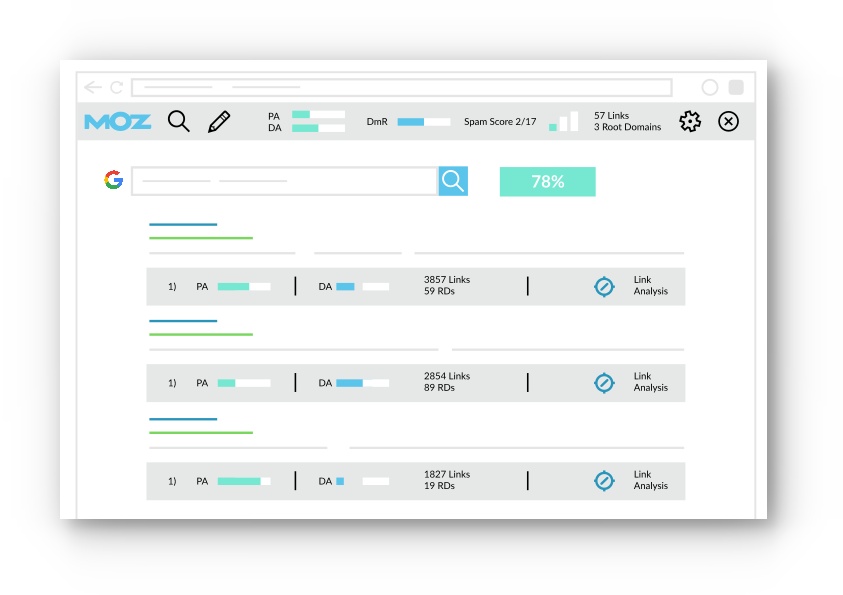Whether you’re building a content marketing strategy from scratch, or want to optimize a current marketing plan, competitor analysis can provide you with valuable insights and ideas. Knowing what your competitors are doing allows you to build a dynamic and agile content strategy that ensures you stand out, while focusing on the topics and content that your audience is craving.
To start, download your free competitor analysis checklist and template. Use these resources to keep all your research organized in one place as you collect your data and follow along with the guide.
Find the Worthy Competition
Step one is finding the companies and brands that you’ll research and follow. These should be both direct and indirect competitors. For example, as a local business, you want to look at both local companies along with national organizations. Don’t be afraid to cast a wide net, the more information, the better.
Start your research with Google and social media sites, including Twitter, Instagram, Facebook, Reddit, Pinterest—wherever you think your audience can be found. Search for hashtags or keywords that relate to your business to start crafting your list. Once you find competitors, look at the other profiles they follow to dig one layer deeper.
This will yield you a large list, so refine by only including companies that:
- Regularly publish content on their website and/or blog
- Actively post and engage on social media
- Optional: Have an email list*
*If email marketing is critical for your brand, you’ll need to assess email marketing of your competitors; and they need to have one in the first place. To figure this out, look for free downloads (like whitepapers, guides or case studies) along with subscriber sign up pages or pop-ups.
When refining your list based on this criteria, keep these two important tips in mind:
Get Specific When Choosing Competitors
Don’t spend time researching businesses in a different vertical; the goal is to find businesses that market to the same audience as you and do it well.
For example, my Marketing Coordinator, Tracy Ring, managed the social media for a national paintball park company that targeted mothers, families, and school groups.
Since the business was unique (not many other paintball companies run at that scale), she researched other recreational-based activities with similar audiences, like trampoline-zones, go-kart racing, and summer camp programs.
Find the Shining Stars
You might be a small business with a small budget, but you should also include big companies with next-level marketing. With the paintball park company, the “shining stars” were theme parks like Disneyland.
You might not be able to duplicate their content marketing, but you can find inspiration and start to understand what works for the big brands, who are also spending big bucks on professional market research.
For more metrics to gauge brands and their websites, download the Moz SEO Toolbar to check domain authority (DA). The higher the DA, the more established and successful the website is.

Competitor Analysis Checklist
With your competitors chosen, it’s time to analyze their content marketing. Use these areas of focus to make sure you capture all the most important information. Remember to download the checklist and template to collect and organize your information.
Step 1: Get the Basic Website Data
When you have a list of competitors, it’s time to gather the basic information, which you can get from SimilarWeb.

Once you put the competitor’s website into the search at the top of the homepage, you’ll dig through the report and pull out:
- Total traffic
- Top 5 organic keywords
Make note of competitors and similar sites in the report as well, and use that to cross-check your own list. Add any that you feel are relevant, but aren’t included on your list yet.
To get Domain Authority, use the free Mozbar.
*Don’t count any branded organic keywords, like those related to their business name. It will be hard for you to rank for these, and in most cases, you don’t need to.
Step 2: Evaluate Your Competitor’s Content Formats
There are many content types that you can play with and some work better for certain industries or audiences. Instead of trying to figure that out on your own, look to the established companies in your vertical and see what mediums they use. Here are some content formats to look for:
- Blog posts: This is likely the most common medium you’ll see. Note whether their content is short-form (300-700 words) or long-form (700+ words). Some audiences prefer one over the other.
- E-books: Long-form digital books, usually presented as top-of-the-tunnel, gated content to drive leads.
- White papers: Based on research, usually long-form content that includes data analysis, and is also often gated. You’ll see this most often with B2B companies targeting higher-level decision makers.
- Videos: Visual content, either live or pre-recorded. You might see this on social media, as well as on landing pages and in blog content.
- Email blasts or newsletters: Sent out to company’s subscriber or customer lists. If you see a subscribe page, sign up and then track their newsletters and drip emails as they come in. What are they talking about? How often do you get emailed?
- Case studies: This short-form content outlines a company’s project or client success, including their processes and results. Note images used—graphics? Customer images?
- User-generated content: Often you’ll find this in the form of reviews or testimonials from clients or customers. Instagram is a popular platform for UGC, where brands repost images from customers. Feeling Lost? Learn how to use user generated content for your small business.
If you want a deeper dive, check out Adspresso’s guide to content formats.
Step 3: Look for Content Gaps
As you assess content types, look for gaps in topics covered by your competitors. The goal is to see what’s already out there and what’s not so you can develop fresh and unique angles.
As Joe Pulizzi, founder of Content Marketing Institute, explains: “Our job, as marketers, is not to create more content. It’s about creating the minimum amount of content with the maximum amount of behavior change [for] our customers.” Pulizzi continues: “For that to be possible, what you create has to be valuable, useful, compelling and, yes, different.”
Keep a running list of popular topics in the same spreadsheet; in the free download, there’s a space for this.
Step 4: Assess the Quality and Quantity of Your Competitors’ Content
Now that you’ve found your competition and determined what the formats they use for content marketing, it’s time to see how well it’s working. At a high-level, you want to uncover:
- How many blog posts do they publish each month?
- How many e-books, case studies, etc. do they have?
- How does their content perform socially?
- How many backlinks do those pages have?
Here are a few methods for figuring that out.
Public Distinguishers: Use Buzzsumo’s content analyzer, which displays total social shares for pieces of content. Input the site’s domain and you’ll get a list of posts that can also be exported. Note that you can only see a limited list unless you sign up for a Pro account. Save money by signing up for a month and then canceling when you’re done.

Don’t forget to do the manual work of reading through comments on social media posts. Use this to get real-life insights. What do people agree with, trash on, or enjoy?
Backlinks: Another signal of great content is the number and quality of backlinks pointing to their blog posts, ebooks and other content pieces. Use Ahref’s Free Backlink Checker to assess their backlink profile.
Look at the backlinks and referring domains numbers. Make note of the percentage of do-follow. Do-follow links are the ones you want, this is a good indicator, assuming they have high-quality sites pointing back to their site. While this won’t dictate your strategy, it’s an interesting number to look at as you compare the various sites. Most importantly, navigate to their “Top 5 Pages” for this part of the analysis—these are the ones you want to emulate.

Find more great competitor analysis tools in this guide from Propel. Add the successful and innovative content examples to your list. You can include links to the content, as well as general ideas, topics and keywords that you’ve found to be most successful and relevant to your brand.
Step 5: Put Your Competitor Analysis Into Action
Now’s the time to dig into the data and pull out insights you can use to build a content marketing strategy that’s competitive. Here are a few analysis points to consider as you look back through the information:
- What content topics are most popular with their audience?
- Do they gain most of their traffic from social media, organic traffic or paid?
- What social media platforms do they get the most traffic from?
- Where are there gaps in their content topics?
- How often do they publish? Can you make an inference about the number of posts published and total traffic, based on data you see for other competitors?
Continue asking yourself questions like this. Do what marketers do and dig into the data and let it lead you to conclusions that will inform your content marketing strategy and then put your insights to work by creating your content calendar—get the free Quarterly Content Calendar Bundle to organize your ideas.
Don’t forget to regularly check your own work to see if your assumptions were correct. Refer to this guide on content marketing metrics for help with reporting if that’s new for you as well. Continue to benchmark against yourself and your competitors and you’ll get the most out of your content marketing efforts. Don’t forget to download your free checklist and template below!
[mailerlite_form form_id=7]



